The next-gen MacBook Pro with Retina Display Review
by Anand Lal Shimpi on June 23, 2012 4:14 AM EST- Posted in
- Mac
- Apple
- MacBook Pro
- Laptops
- Notebooks
GPU Performance
We’ve already established that NVIDIA’s Kepler architecture is fast, but the GeForce GT 650M used in the rMBP is hardly the best NVIDIA has to offer. The result however is a significant improvement in performance over the Radeon HD 6750M used in the previous generation model.
| 15-inch MacBook Pro Model | Mid 2010 | Upgraded Early 2011 | Upgraded Late 2011 | Retina |
| GPU | GeForce GT 330M | Radeon HD 6750M | Radeon HD 6770M | GeForce GT 650M |
| Cores | 48 | 480 | 480 | 384 |
| Core Clock | 500MHz | 600MHz | 675MHz | 900MHz |
| Memory Bus | 128-bit GDDR3 | 128-bit GDDR5 | 128-bit GDDR5 | 128-bit GDDR5 |
| Memory Data Rate | 1580MHz | 3200MHz | 3200MHz | 5016MHz |
| Memory Size | 512MB | 1GB | 1GB | 1GB |
The GT 650M offers fewer “cores” compared to the 6750M and 6770M used in previous MacBook Pros, but likely better utilization of the available hardware. NVIDIA also clocks the cores much higher in the 650M, the result is a ~20% increase in theoretical raw compute power.
The memory bandwidth story is also better on Kepler. While both the GT 650M and the 67xxM feature a 128-bit GDDR5 interface, Apple clocked AMD’s memory interface at 800MHz compared to 1254MHz on Kepler. The resulting difference is 80.3GB/s of memory bandwidth vs. 51.2GB/s.
The real world impact is most noticeable at higher resolutions, thanks to the tremendous amount of memory bandwidth now available. The other benefit from the new GPU is obviously things run a lot cooler, which as I’ve already shown to considerably reduce thermal throttling under load.
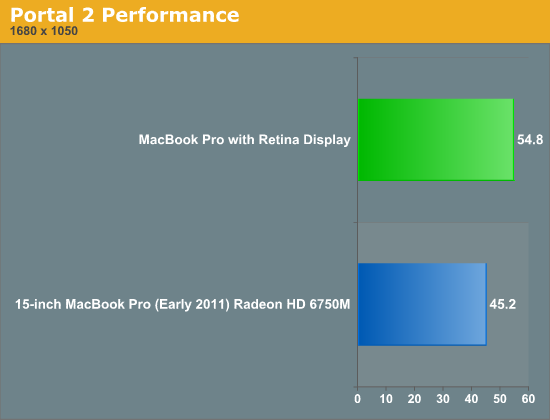
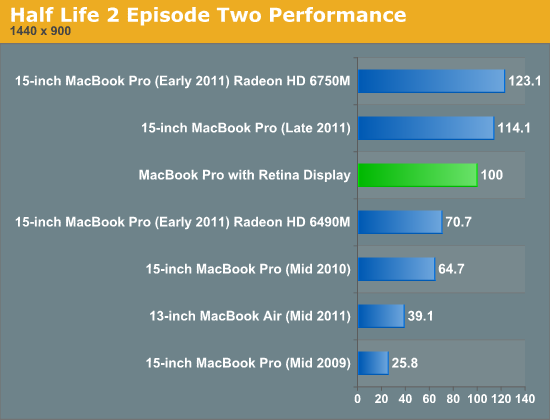
At 1440 x 900 we actually see a regression compared to the 2011 models, but differences in the AMD and NVIDIA GPU drivers alone can account for the difference at this hardly GPU bound setting. Look at what happens once we crank up the resolution:
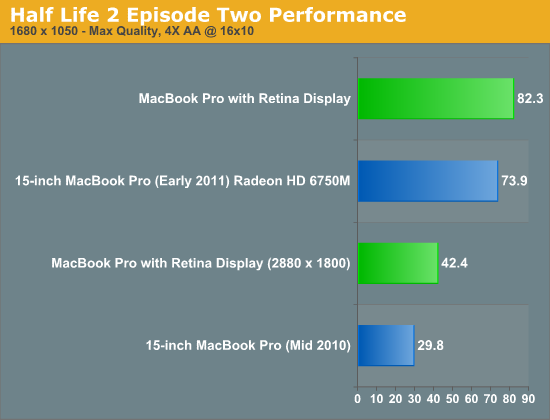
At 1680 x 1050 with 4X AA enabled we see a modest 11% increase in performance over last year's MacBook Pro. As I established earlier however, the rMBP will be able to more consistently deliver this performance over an extended period of time.
What's even more impressive is the 42.4 fps the GT 650M is able to deliver at the rMBP's native 2880 x 1800 resolution. Even though I ran the test with AA enabled I'm pretty sure AA was automatically disabled. At 2880 x 1800 the rMBP is able to outperform the two year old MacBook Pro running at 1680 x 1050. How's that for progress?
While the gains we've shown thus far have been modest at best, Starcraft 2 is a completely different story. Here for whatever reason the IVB + Kepler combination can be up to 2x the speed of last year’s models. I reran the tests both on the older and rMBP hardware to confirm, but the results were repeatable. The best explanation I have is Starcraft 2 is very stressful on both the CPU and GPU, so we could be seeing some thermal throttling on the older SNB + Turks hardware here.
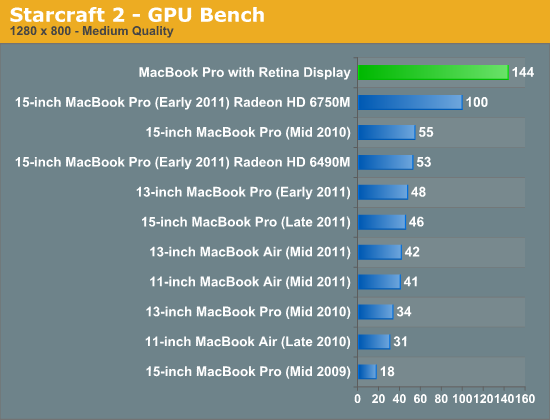
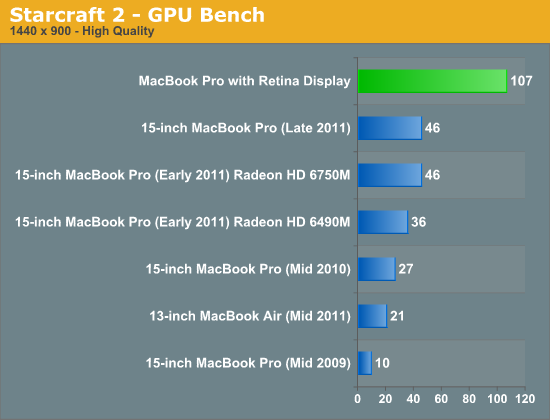
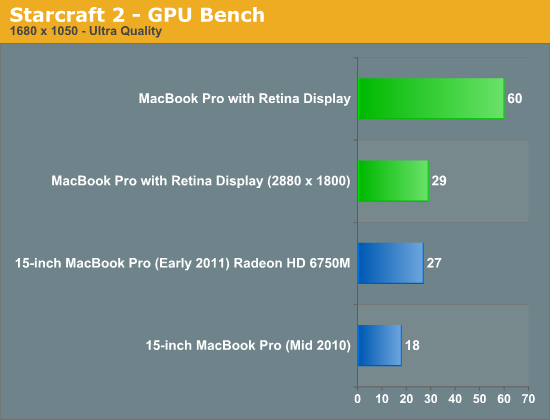
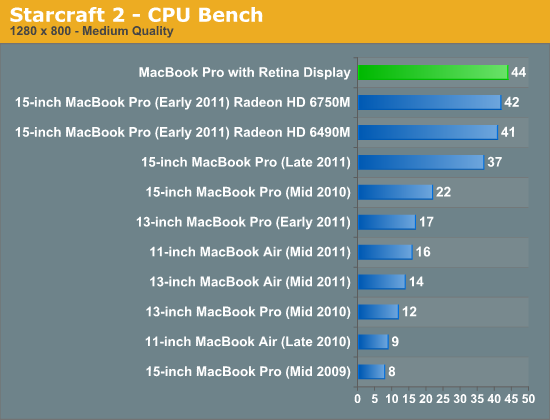
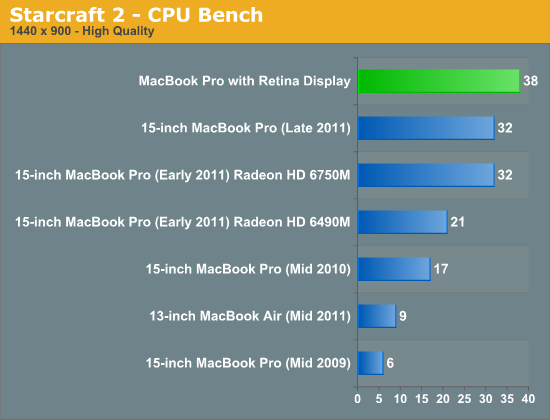

Once again we see playable, although not entirely smooth frame rates at 2880 x 1800. I've also included a screenshot of SC2 at 2880 x 1800 below:
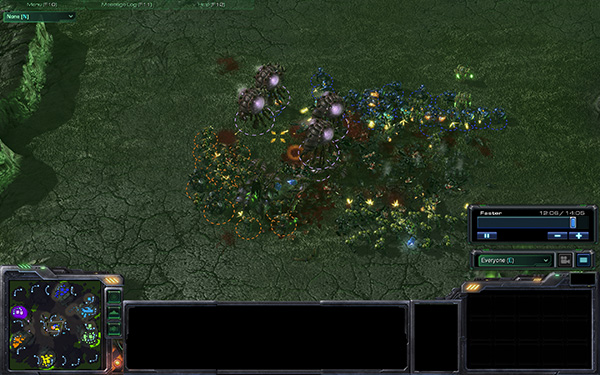
Starcraft 2 at 2880 x 1800, it's playable
Although gaming options continue to be limited under OS X, Diablo 3 is available and finally performs well on the platform thanks to the latest patches. Diablo 3 performance is appreciably better on the GT 650M compared to last year’s 6750M. There’s no FRAPS equivalent under OS X (free advertising to the first eager dev to correct that) so I have to rely on general discussion of performance here. The GT 650M is fast enough to drive the rMBP’s 2880 x 1800 panel at native resolution at playable frame rates, around 18 fps on average. Connected to an external 2560 x 1440 display however the GT 650M is fast enough to deliver around 30 fps in Diablo 3. For what it’s worth, performance under Diablo 3 is far more consistent with the rMBP than with last year’s MacBook Pro. I suspect once again we’re seeing the effects of thermal throttling under heavy CPU/GPU load that has been well mitigated by the move to more power efficient silicon.



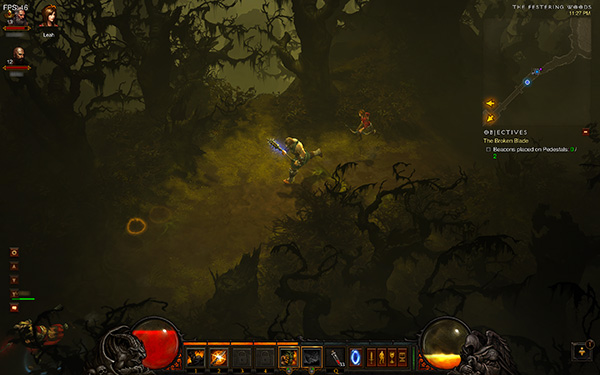








471 Comments
View All Comments
Ohhmaagawd - Sunday, June 24, 2012 - link
It's a first step. There will be retina monitors in the future.Freakie - Monday, June 25, 2012 - link
Lolwut... Monitors that have great quality color are already high resolution... They were pushing major pixels before it was popular ;)vegemeister - Monday, July 2, 2012 - link
With the exception of the (discontinued and originally $10,000) IBM T221 and it's derivatives, no desktop monitor has resolution exceeding 2560x1600, and that resolution is only available in the 30" form factor.Solandri - Saturday, June 23, 2012 - link
I have the lower-end version of that particular laptop ("only" a 1600x900 screen, 2x64 GB SSD). I wish I'd opted for the 1080p screen. 1600p wide isn't really enough to put two apps side-by-side. I do that all the time on my 1920x1200 external monitor though.The screen is a glossy TN panel, but is pretty much the best TN panel I've used. My desktop monitor is IPS so I can see its limitations. But when I'm using the Z in public, the most frequently comment I get is how beautiful the screen is. Sony also does a stellar job with their anti-reflective coatings. it's a glossy screen, but I almost never see reflections (except in sunlight). Colors are a bit too saturated, and the custom color profile I made tones it down. Unfortunately none of the reviews on it tested its gamut. But from photo editing, it's got a wider gamut than most high-end laptop displays I've seen. And it's blindingly bright too - perfectly usable in direct sunlight at max brightness. I rarely run it over half brightness.
The quad-SSD was because the laptop came out before SATA3 SSDs were available (the SATA3 spec had only been finalized a few months prior). 2.5" SSDs were already hitting the limits of SATA2 (3 Gbps) and the only way to get around it was by putting multiple SSDs in a RAID 0 array. So that's what Sony did. The 4-SSD version benchmarks at 430-500 MB/s sequential read/write. Not too shabby in 2010 using 150 MB/s mSATA stick SSDs on SATA2.
Optical drives are more a matter of preference. I end up burning a lot of DVDs so it's definitely convenient. But if you don't do that or watch movies, then yeah I can see it being superfluous. As much as I'd like to see media being distributed on USB sticks, their cost of $1-$2 for 4GB vs. a few cents for a DVD means it's not happening yet. Do note that the Z tops out at 2.9 pounds. It's lighter than the first and second gen Macbook Air despite having a DVD/Bluray drive. That's the second most common comment I get - "It's so light!"
OCedHrt - Sunday, June 24, 2012 - link
The 1080p panel on the Z is IPS. And it's not glossy - you don't have a glass on your laptop. I believe this is more for weight reasons than anything else.maratus - Sunday, June 24, 2012 - link
No, it's not IPS.Solidstate89 - Saturday, June 23, 2012 - link
You have to be the most ignorant jackass I've ever seen. You've basically never even heard of that product until now yet that doesn't stop you from making baseless accusation after baseless accusation.Get the fuck over yourself. And Windows has always handled resolution scaling better than OS X, and it still does.
ananduser - Saturday, June 23, 2012 - link
In 2010 Sony offered a 13" MBP equivalent with matte 1080p TN panel(like all the other macbooks). It had a BluRay built besides a quad raid SSD option(that still exists). The current Z has the video card inside an external dock, it is as slim as the thinnest ultrabook with a full voltage CPU.OCedHrt - Sunday, June 24, 2012 - link
Sony offered it in 2008 :)OCedHrt - Sunday, June 24, 2012 - link
You are not applying the correct context.1080p is okay because windows has DPI scaling - though I agree with Anand that this doesn't work with apps that aren't written correctly. But the same applies to OS X. OS X handles it better because of vector based UI.
It is an IPS display with 92% color gamut that Anandtech called amazing. Don't even try to pretend it sucks: http://www.anandtech.com/show/5530/sony-vaio-z2-ev...
Blu-ray is not a default option, it is an extra configuration that you'd have to pay for. This isn't Apple were talking about - even Sony has typically more options than Apple.
Quad-SSDs. Yes. You need to remember that his happened back in 2008 when SSDs were not doing 500mb/sec. This was back when a quad SSD only netted you about 300mb/sec and before TRIM was prevalent.